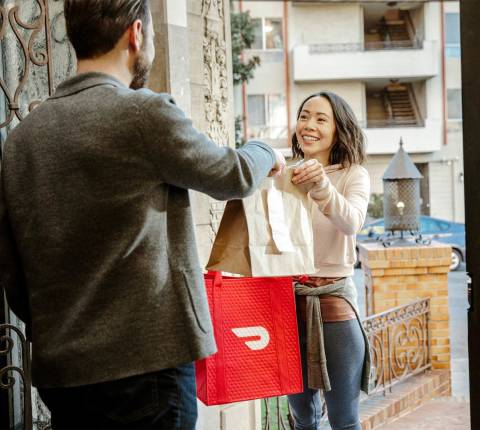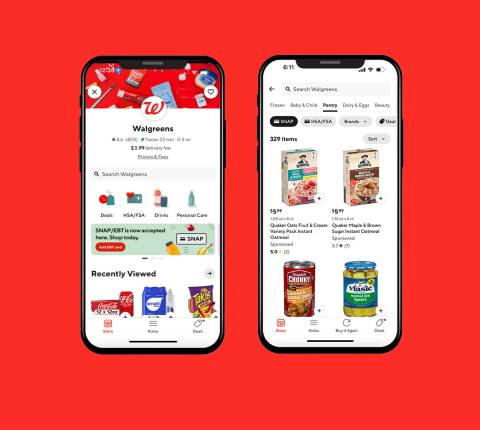Earlier today, DoorDash CEO and Co-Founder Tony Xu shared this note with employees to celebrate DoorDash’s 10th anniversary:
It’s been said that we tend to overestimate what we can accomplish in a year and underestimate what we can get done in 10 years. DoorDash launched 10 years ago today, and when I reflect on our journey together so far, I definitely agree with this oft-held view.
Here’s what DoorDash looked like 10 years ago on launch day.

We launched with a website that offered delivery from just a couple dozen restaurants in Palo Alto. There was no consumer app, no other delivery areas beyond Palo Alto, and no categories beyond restaurants. There was no way to know when your Dasher was getting close to your dropoff, no app to help a Dasher navigate or even know how to receive orders, no app for a Merchant to receive or edit an order. There wasn’t even an option to order breakfast as we only operated under 6 hours each day. But we saw a problem to solve for local businesses and had a point of view on how we could build the last mile logistics network for every city – starting with restaurants – and over time help all local businesses win. After all, we always saw ourselves as a technology company whose first product was powering food delivery vs having the end goal of becoming a food delivery service. We dreamt big but started small – super small.
Here are some photos that described the early team and office environment.




All of the furniture in this apartment that we called an office cost less than $2000 (thank you IKEA!). The last photo is a celebration of our very first Dashiversary as a company, which was celebrated at a park in Palo Alto.
Every person in that photo completed deliveries, performed customer support, placed orders, created menus, managed restaurant accounts, and onboarded Dashers. We each did all of the things because we deeply wanted to understand our customers, learn how to master our craft and how to prioritize our product roadmap. One of the things I’m most proud of is how all of you continue to embody that same customer obsession 10 years later. It shows up in our weekly and monthly reviews, our daily conversations with customers, programs like WeDash and WeSupport, how you work with merchants to grow their business, and all the ways you stay close to and solve problems for our customers.
While there are many stories from the past decade that we’ve experienced as a team, I wanted to share three that I believe represent well our journey, ethos and the way in which we’ve built and are building DoorDash.
Three months after we started DoorDash (in 2013), Stanford had its first home football game of the season. I remember vividly the start time of the game on that September Saturday because it was unusual in that it was close to noon. And when the game ended a little after 4PM, our system was flooded with orders. It was awful. Demand overwhelmed our supply of Dashers, and even though our entire team went out to perform deliveries, we were on average late on each order by over an hour. To make matters worse, we were also running out of money as a company because, as CEO, I still hadn’t secured our seed financing. Without hesitation, though, my co-founders and I decided to refund every single order from that night. It meant spending ~40% of our remaining runway, but it was absolutely the right thing to do for our customers. We issued the refunds and stayed up all night, baking cookies and writing personal apology notes to each customer we disappointed. By 5AM the next day, we delivered each of these care packages. While we never reflected more than 30 seconds on the story then, it stands as a consequential decision we reference often over the years when faced with tough decisions under pressure. Solving for the customer has been and remains our North Star and the highest expectation we strive to exceed. We’d rather die trying to be excellent than live to be mediocre.
The second story is really a collection of three difficult years compressed into one memory. Between March 2015 and March 2018, there were about 1000 days in which I had a hard time fundraising for DoorDash and there were some weeks when we came perilously close to running out of cash. Some of our peers had raised 50-100x more capital and many investors lost faith, fearing that we’d be outmatched. Internally, some people were losing faith, too, and left for what seemed like surer bets. After all, this was a scale game – DoorDash was in fourth place in our category and last place when it came to capital. But overwhelmingly, our team of underdogs stuck together, building a better product for each of our audiences, enabling us to accomplish more for them with less. Throughout these three years, we continued growing, improved our unit economics, and gained on our peers. It wasn’t a straight line of up and to the right, and it certainly felt a lot worse than that in those years. But the daily commitment to show up, think differently, chase excellence, compete by winning on the product, and play for each other is the massive through line in surviving those 1000 days in the desert. Ultimately, investors took notice and we survived long enough to receive that one “yes” that enabled us to do even more for our customers. And by winning on the product, we were able to deploy the capital we had secured in an efficient manner to ultimately build the largest platform in the industry. By the time we went public, we had – in the bank – the majority of our lifetime capital that we had raised.
The final story covers the first few weeks after COVID-19 appeared in March 2020. While it wasn’t clear that restaurants would be allowed to offer takeout and delivery at the onset of the pandemic, once the green light was given by governments around the world, our order volume doubled almost overnight. During those initial weeks, our teams pulled together in a herculean effort. To help Dashers stay safe on the road, teams across DoorDash sourced and distributed millions of units of PPE and built a logistics setup to enable contactless delivery. Together, we onboarded tens of thousands of merchants who needed a lifeline as their dining rooms had been shut down even though their kitchens were open for delivery. We accelerated a year’s worth of our engineering roadmap such that our infrastructure could support our growth, and we created a remote work setup for tens of thousands of our customer service agents whose call center offices had been closed. During that time, we reduced our commissions by 50% (the only service to do so), investing hundreds of millions of dollars to support our merchant partners. We also bought a multi-million dollar ad campaign that asked consumers to order delivery across any platform, including on our competitors’ apps. To us, the moment was bigger than ourselves, and we wanted to choose optimism, execute quickly on our plans, and lead.
Fast forward to today, had you asked each of the team members in that photo of the apartment / make-shift office what DoorDash would have looked like 10 years post that first day at launch, surely none of us could have predicted this journey. But, none of us thought too much about the outcome then. We just wanted to get started, and we deeply believed that if we were able to achieve our mission to grow and empower local economies, that we’d help have an impact that would make us proud.
In many ways, this is still what motivates all of us today. I am proud of the progress we’ve made toward becoming the leading global company for local commerce. In 10 years, we’ve generated over $100B in sales for local businesses, helped Dashers earn tens of billions of dollars, produced hundreds of billions of dollars of economic impact for thousands of cities across more than 25 countries (with both the DoorDash and Wolt brands), and have been described as both a noun and a verb in millions of households. I am deeply appreciative to all of the audiences we serve, and I am forever grateful for the opportunity to work alongside the tens of thousands of teammates past and present who have helped build DoorDash in this first decade.
Yet, we’re just scratching the surface. The growth of local commerce is still in its early innings as merchants on Main Street are transforming every part of their business to serve the digital and convenience economy. Most categories of local commerce are still offline and while merchants have grown in sophistication, they still trail the massive ecommerce giants in meeting consumers where they are. Crucially, it’s still these small, medium and large physical businesses that continue to produce the majority of jobs and GDP inside every city. Helping them succeed is in our DNA at DoorDash. We’ve made headway to build some of this infrastructure, and our mission to grow and to empower local economies is as worthwhile today as it was 10 years ago.
Happy 10th Dashiversary, DoorDash! Thank you to everyone who has helped us reach this milestone – let’s keep building!
Onward and upward,
Tony



